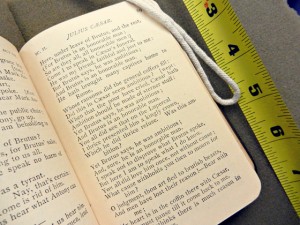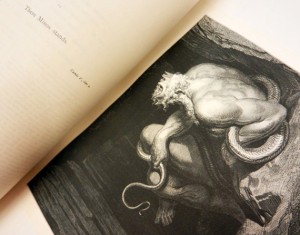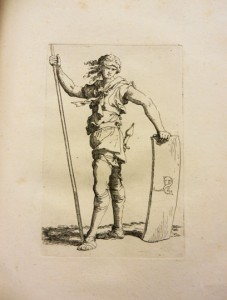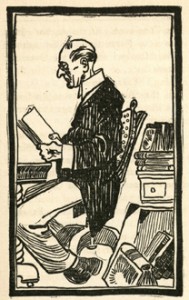
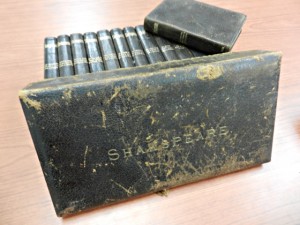
The Handy-Volume Shakespeare (1885)
In addition to the over 7,000 linear feet of archival collections made available for study at the University of Houston Special Collections, we are also proud to offer over 100,000 rare books for use in our reading room. Each month we will highlight an item from our collections and what makes it so special.
Book of the Month: The Handy-Volume Shakespeare (1885)
Why so Special? One hundred thirty years young, this 13 volume set of Shakespeare’s plays, poems, and sonnets are particularly, conveniently sized at a mere 12 x 8 x 2 centimeters (a mere fraction of the size of most devices jangling around in our pockets these days). Those lucky enough to be early adopters of this G. Routledge imprint could conveniently carry a copy (or two) of Mids. N. Dream, Anton. Cleo., or Romeo Ju., depending on one’s appetite. Included in the last volume is a handy glossary, so readers of the late nineteenth century could easily dive into the Bard’s rich language and find that a “lavolta” is indeed, “a spritely dance,” while “tickle-brain” is “some strong intoxicating liquor.”
Location: Anyone interested in viewing these full-course-meals masquerading as morsels of comedy, history, and tragedy are invited to visit the UH Special Collections Reading Room during our normal hours of operation. The Handy-Volume Shakespeare may be called via PR2753 .D2 1885. Magnifying glass available upon request.
In addition to the over 7,000 linear feet of archival collections made available for study at the University of Houston Special Collections, we are also proud to offer over 100,000 rare and antique books for use in our reading room. Each month (some more dutifully than others) we will highlight a text from our collections and what makes it so special.
In the spring 2015 semester we had the good fortune to host our first-ever UH Special Collections Social Media Intern, Shelby Love. As part of her duties, Love curated a number of selections for our Book of the Month series here on the blog. For this month (and many to come, no doubt) we share a Book of the Month selection from Shelby Love.
Book of the Month: The Vision of Hell by Dante Alighieri, translated by Henry Francis Cary, and illustrated with the designs of M. Gustave Doré.
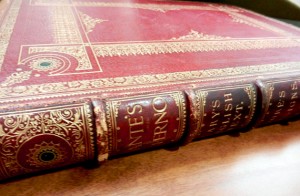
“Abandon all hope, ye who enter here.” The Vision of Hell by Dante Alighieri
Why so Special? In this 1866 edition, Dante Alighieri’s literary masterpiece is skillfully presented through the two archetypal interpretations of Henry Francis Cary and M. Gustave Doré. Cary, a graduate of Christ Church College, Oxford and assistant librarian in the British Museum, translated the Divine Comedy from Italian to English in the early 1800s. Despite the availability of numerous alternative translations, Cary’s version remained the standard into the twentieth century. That would be over 100 years of beating his competitors. In fact, his poetic translation was admired by other literary giants such as Wordsworth, Keats, Lamb, Coleridge, Macaulay, and Ruskin. Cary dedicated countless hours and even his own funds to complete the project for public consumption, truly a meritorious example of just how important our librarians are to society.
The second distinguished interpretation is through Doré’s vivid illustrations of the otherworldly adventure. Doré was an incredibly successful and productive French illustrator and printmaker in the 19th century known for his imaginative and fantastical artwork. His work was mainly centered around themes like the (pessimistic) fate of mankind and meditations on life and death, making him and Dante such a compatible ideological pair, the likes of which even match.com couldn’t hope to recreate. In fact, one contemporary critic found the illustrations to be so conscientious that he suggested Doré and the long deceased Dante were communicating through the occult. Dante enthusiasts and scholars still consider Doré a determiner for how the Divine Comedy is visualized by readers today, ranking his hypnotic renderings along with those of Sandro Botticelli, William Blake, Eugène Delacroix, and even Michael Angelo.
With a detailed red and gold hardcover, this edition is one of the most eye-catching items among our larger-format books. The sheer size of it can strike the modern day book lover as both whimsical and puzzling, eliciting the question, why would such a serious classic need to be so colossal? A rewarding perusal in the reading room will reveal a uniquely intimate way to engage with Dante’s beloved classic as Cary’s poetic translation of the writer’s imaginative vision is presented side by side with Doré’s exquisite renditions of the literary masterpiece. This incredible edition contains the crowning achievements of three fruitful lifetimes, brought together by one vision.
Location: Those interested in consulting with this edition of Dante’s classic may request call number PQ4315.2 .C4 1866 in the Special Collections Reading Room.
In addition to the over 7,000 linear feet of archival collections made available for study at the University of Houston Special Collections, we are also proud to offer over 100,000 rare and antique books for use in our reading room. Each month we will highlight a text from our collections and what makes it so special.
This spring semester we have been fortunate to host our first-ever UH Special Collections Social Media Intern, Shelby Love. As part of her duties, Love has been curating our Book of the Month series here on the blog. For this month (and many to come, no doubt) we share a Book of the Month selection from Shelby Love.
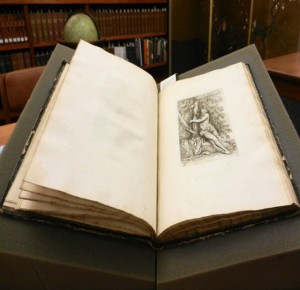
Salvator Rosa has ludentis oty Carolo Rubeo singularis amicitiæ pignus D.D.D. open to display female figurine
Book of the Month: Salvator Rosa has ludentis oty Carolo Rubeo singularis amicitiæ pignus D.D.D.
Why so Special? Salvator Rosa has ludentis oty Carolo Rubeo singularis amicitiæ pignus D.D.D. is a series of etchings by Salvator Rosa, an Italian painter and printmaker. The book was dedicated to Rosa’s Roman patron Carlo de’ Rossi. The book contains beautifully detailed portraits of peasants, women, and groups of soldiers as well as some mythological scenes. Rosa is considered to be one of the most original artists and bizarre characters of the 17th century.
The collection in this book features many etchings from Rosa’s figurine series, which went on to influence many Italian artists as elegant “stock” figures to incorporate into their works. Without the ability of color, Rosa’s traditional prints illustrate the versatility of the line to distinguish subject from object, light from shadow, and detail from outline.
This item presents a rare opportunity to experience the intricate and original artwork without the unfortunate distortion and separation of museum glass. The texture of the plate is softly written into the fabric of the paper and the viewer can also see the indention made into the paper from the plate’s edges after being run through the engraving press. These details bring the viewer excitingly close to the printmaking process that was used to create these images in a way that only originals can. Aesthetically engaging and enlightening, this collection by Rosa is just one captivating gem in Special Collections.
Location: Those interested in viewing this series of etchings in person may request call number ND623.R7R7x in the Special Collections Reading Room.
In addition to the over 7,000 linear feet of archival collections made available for study at the University of Houston Special Collections, we are also proud to offer over 100,000 rare and antique books for use in our reading room. Each month we will highlight a text from our collections and what makes it so special.
Book of the Month: The Spirit of Houston. The First National Women’s Conference. An Official Report to the President, the Congress, and the People of the United States, published by President Jimmy Carter’s National Commission on the Observance of International Women’s Year.
Why so Special? A number of reasons, really.
First, there’s the timing. Whether you’ve been celebrating Women’s History Week since 1981 or you go all the way back to 1909 and celebrated International Women’s Day last weekend, one thing is certain–March is Women’s History Month. Then, what time like the present to view this report and delve back into a history that captures a moment in time when so-called second-wave feminism was on the rise, the world was beginning to notice, and, for a moment, Houston found itself at the epicenter of the domestic debate and struggle.
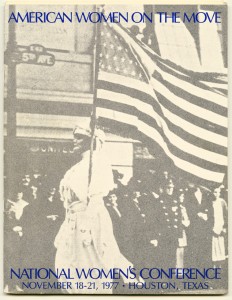
cover of “American Women on the Move, National Women’s Conference” (1977, Marjorie Randal National Women’s Conference Collection)
The timing of the events that brought about this report is also worth noting. When the United Nations declared that 1975 would be “International Women’s Year,” President Gerald Ford established the National Commission on the Observance of International Women’s Year. In the wake of 1975, the work taken on by UN partnerships, and the issues and questions raised from the World Conference of the International Women’s Year (held in Mexico City in the summer of 1975), President Carter’s Commission proposed a National Women’s Conference to take place in Houston in 1977. That November 2,000 delegates from all fifty states and six territories descended on Houston along with an estimated 20,000 observers in attendance. Included among these numbers were first ladies, activists, artists, writers, and more. The topics addressed and reported on by the Conference seemed to buoy support for the floundering Equal Rights Amendment on through 1978. President Carter expressed as much in his comments on the one-year anniversary of the Conference, including ratification of the ERA to be among the goals necessary “for all citizens to participate fully in every part of American life.”
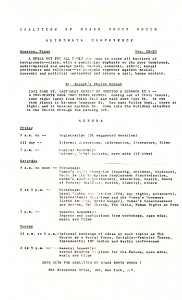
The National Women’s Conference was not the only conference in town: agenda for the “Coalition of Grass Roots Women Alternate Conference” (1977, Marjorie Randal National Women’s Conference Collection)
Or, maybe what makes this report so special is the tip of the research iceberg it represents. The Spirit of Houston… is just one title in the larger Peggy Hall Collection. Hall was a charter member of Houston Area NOW, active member of the Harris County Women’s Political Caucus on issues related to the ERA, and witness to the events of 1977. Examples of other works comprising the collection bearing her name include Notes from the Third Year: Women’s Liberation (a collection of radical feminism that includes Judy Syfers’ biting essay “I Want a Wife,” just prior to its appearance in the premier issue of Ms. magazine) and the iconic 1972 Our Bodies, Ourselves. But, if you had rather keep your focus on the First National Women’s Conference, maybe you would be interested in the Marjorie Randal National Women’s Conference Collection. Randal, an active supporter of women’s rights in the greater Houston-Galveston-Gulf Coast region, was also involved in the events of 1977 and played critical roles in establishing local NOW chapters. Her collection features correspondence, newsletters, publications, and other assorted materials dating from the mid 1970s into the 1980s, with the bulk of the materials focusing on the critical year of 1977 and the National Women’s Conference.
Location: The Spirit of Houston… is available for study this and every month in the University of Houston Special Collections Reading Room (call number HQ1403.N34 U54 1977). Interested in viewing this report or any of the other resources mentioned above? Then, we look forward to your visit to Special Collections.
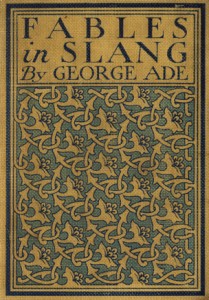 In addition to the over 7,000 linear feet of archival collections made available for study at the University of Houston Special Collections, we are also proud to offer over 100,000 rare and antique books for use in our reading room. Each month we highlight a text from our collections and what makes it so special. This month’s selection is contributed by Library Specialist for Liaison Services and Curator for the new Unique Holdings brown bag lecture series, Kristine Greive.
In addition to the over 7,000 linear feet of archival collections made available for study at the University of Houston Special Collections, we are also proud to offer over 100,000 rare and antique books for use in our reading room. Each month we highlight a text from our collections and what makes it so special. This month’s selection is contributed by Library Specialist for Liaison Services and Curator for the new Unique Holdings brown bag lecture series, Kristine Greive.
George Ade’s Fables in Slang is a collection of satirical fables with titles like “The Fable of the Martyr who Liked the Job” and “The Fable of the Professor who Wanted to be Alone.” Originally published in a Chicago newspaper, these tales mock all the personality types of late nineteenth century America. Even better, the fables are thoroughly illustrated in a bold, exaggerated style, and each ends with a sarcastic moral. In “The Fable of the Man who Didn’t Care for Story-Books,” for example, a man decides that contemporary literature is “all a mockery,” describing all the literature he has read and found lacking. The story concludes with the moral that “Only the more Rugged Mortals should attempt to Keep Up on Current Literature.”
Read a few of Ade’s fables and you’ll join a group of admirers that stretches back over a hundred years. Ade was enormously popular in the early twentieth century; in fact, the advertisement for his other books in the back of Fables in Slang asserts that “Mr. Ade’s books are too well known to require comment here.” He had influential fans, too: Taft held his first presidential campaign rally at Ade’s home, and Theodore Dreiser so admired Ade’s gift for description he even lifted a passage from his fables for use in the original edition of Sister Carrie. In his book on Ade, Lee Coyle locates a passage in the letters of Sir Walter Alexander Raleigh calling Ade “the greatest living American writer, ” an assertion that, while controversial even then, illustrates the name recognition Ade enjoyed in his time. He may not be as well known today, but Ade is forever being rediscovered, with periodic new editions of his works.
Fables in Slang was also recently discussed in The Last Untapped Resource in Houston, the first brown bag lecture in the Unique Holdings series highlighting rare books in our collection. The next event is April 22 and will feature life science books, ranging from centuries old illustrations of mythological animals to contemporary fine press books. In the meantime, why not come to the Special Collections Reading Room and read some fables? Just ask for call number PS1006.A6 F3 1900.
